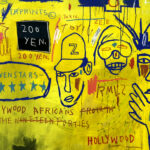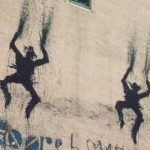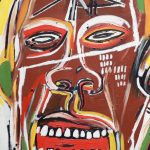Luna Luna is the name of a project that the artist and poet André Heller realized in Hamburg, Germany, in 1987. Luna Luna can be seen as the word’s first art amusement park with rides, games, and attractions by artists like Jean-Michel Basquiat, Keith Haring, David Hockney, Sonia Delaunay, Rebecca Horn and Roy Lichtenstein. After the end of the show in Hamburg, there were plans for a European tour or a sale to Vienna. However, these plans could not be realized. By a twist of fate, the park’s treasures were soon sealed in 44 shipping containers and forgotten in Texas — until now. Parts of Luna Luna are now on view in huge warehouse in Downtown Los Angeles (until May 12, 2024). This video provides you with a tour of the show.
Luna Luna: Forgotten Fantasy. The World’s First Art Amusement Park. Los Angeles, February 22, 2024.
— Right-click (Mac: ctrl-click) this link to download Quicktime video file.
Press release (excerpt):
Guests of Luna Luna: Forgotten Fantasy will witness, for the first time since 1987, the fantastical fairground that appeared in Hamburg, Germany for only seven weeks. Housed in a warehouse complex located on the Eastside of Los Angeles, the exhibition spans 60,000-square-feet and features one-of-a-kind rides and interactive installations by 15 world-renowned artists, including Sonia Delaunay, Salvador Dalí, Jean-Michel Basquiat, Keith Haring, David Hockney, Rebecca Horn, and Roy Lichtenstein.
Passing by a recreation of André Heller’s inflatable Dream Station, guests enter through a midnight blue corridor and are welcomed by a fast-moving video that introduces the original Luna Luna.
The exhibition is divided into two rooms and connected by Sonia Delaunay’s monumental entrance archway with the original Luna Luna sign—and lightbulbs.
Entering the first space, guests are greeted by Kenny Scharf’s painted chair swing ride and freestanding sculptures, David Hockney’s Enchanted Tree and Keith Haring’s painted carousel and industrially fabricated tarps. Alongside these works is Manfred Deix’s Palace of the Winds, Arik Brauer’s Carousel and photo archives by Sabina Sarnitz, who captured Luna Luna’s development in more than ten thousand photographs across multiple cities from 1986 through the park’s opening in 1987.
Guests are transported to the second space through Delaunay’s archway, opening to a grand view of Jean-Michel Basquiat’s painted Ferris wheel, with music by legendary musician Miles Davis. The antique wooden wheel, which dates to 1933, was painted by artisans in Vienna in accordance with Basquiat’s instruction and design—the only instance in which a Basquiat work was executed remotely.
Other works in the space include Salvador Dalí’s Dalídom pavilion, a geodesic dome with a mirrored interior that produces a mesmerizing, kaleidoscopic infinity effect, enhanced by an ambient soundtrack with Gregorian chants by Blue Chip Orchestra. Directly opposite Dalídom is Roy Lichtenstein’s Luna Luna Pavilion, a glass labyrinth encased in Lichtenstein-designed panels with a soundtrack by the Minimalist composer Philip Glass.
Nearby are Daniel Spoerri’s Crap Chancellery, Rebecca Horn’s Love Thermometer and André Heller’s Wedding Chapel, in which, according to Luna Luna’s imaginative law, “anyone and everyone can marry what and whom they want.”
Works by Jim Whiting, Joseph Beuys and Monika GilSing also fill the second space. Here, guests are presented with a timeline—part mood board, part cultural history; a short documentary on Luna Luna, commissioned by André Heller; and videos that showcase the process of reassembling Luna Luna for today.













